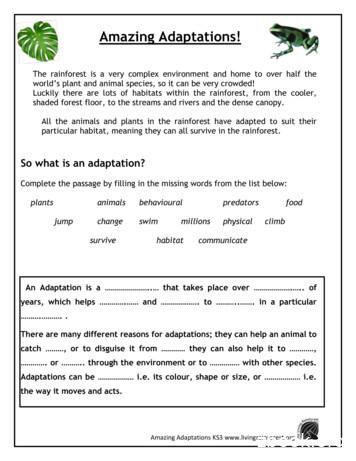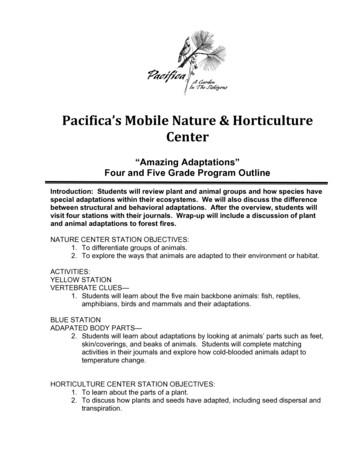4 AMAZING ADAPTATIONS (1) Halophytes: Plants That Love Salt
4. AMAZING ADAPTATIONS(1) Halophytes: Plants That Love SaltHalophytes have found a niche at Bottomless Lakes State Park and Bitter Lakes National WildlifeRefuge by adapting to salty soils. (Field Trip / 45-60 minutes)Strand/CategoriesGradeConnecting with Science StandardsStandard(s)Life Science4/5Forms, structures, habitatsScientific Thinking/Practice454/5Similarities, differencesGenetic traitsScientific methodsGoal: Students will identifyhalophytic (salt-loving)plants and learn how theseplants have adapted tothis environment.Objective:Identify salt cedar, saltgrass, iodine bush, fourwing salt bush and Pecossunflower.Record data andobservations about thesehalophytic plants.Using an electricalconductivity meter,students will test andcompare the amount ofsalt in the soil aroundeach plant.Materials:ClipboardsPencilsData observation sheetsPlant identifications cardsQuart-size, zip-top plasticstorage bagsSmall garden trowelsPermanent markersElectrical conductivitymeterPlastic cupsDistilled waterThe NM Outdoor Classroom ProgramBenchmark(s)Structures, roots, leaves, environmentalchangesSurvival of organisms in environmentInheritable traits, heredityInstruments, investigations, appropriate techBackgroundAre there certain foods that you just have to salt? MaybeFrench fries or popcorn? Salt is essential to life, and we allneed some every day.There are some plants that need salt too. They are calledhalophytes (HAL o fites), or salt-loving plants. They haveadapted over time to living in soils that have much higheramounts of salt than other soils, absorbing the salt throughtheir roots. These plants have learned to live in places andconditions that most plants can’t. Several of these saltloving plants grow at Bottomless Lakes State Park. You’llnotice that much of the soil here is white and salty. Thesesalts form when underground water containing gypsumand salt travels upward through the rocks and soil to thesurface. When the water evaporates, the gypsum and saltare left behind, leaving behind a white crust. This whitecrust helps to create a special niche for local plants like saltcedar, four-wing salt bush, salt grass, iodine bush and eventhe endangered Pecos sunflower.Pass the Salt?Similar to people, these halophytes “sweat” out excess saltthrough salt glands called trichomes. The excess salts areaccumulated and excreted through pores in the plants’leaves. The salt is then re-deposited back into the soil andthe cycle starts all over again. Some plants, like the saltcedar, actually change the soil composition with the saltthey add, giving them a competitive edge over other plants.Bitter Water, Bottomless LakePage 1 of 7
Amazing AdaptationsHalophytes: Plants That Love SaltProcedure I: A Dash of Salt1. Have students divide into teams of 3-4 per group.2. Hand-out clipboards, pencils, plant ID cards, keys and data observation sheets - one pergroup.3. Using the ID cards and keys, students will locate the five different halophytes.4. Once a halophyte is identified, teams will answer questions and list observations abouteach plant.5. After teams find all five plants and return to the starting point, groups will share andcompare their results with each other.Procedure II: Worth Its Weight in Salt1. Give each team a quart-size zip-top plastic storage bag and one small trowel.2. Assign each team one of the halophytes to re-visit. Have team write the name of theirplant on outside of bag with permanent marker.3. Tell students they will be discovering which plant has the saltiest soil by testing theamount of salt in the ground near their plant. Ask students to guess which one they thinkit will be.4. Once teams re-locate their plant, they will dig a small hole near the plant, approximately6-inches deep. Students will put one scoop of soil from bottom of hole into the plasticstorage bag.5. After returning to the starting point, each team will test their soil sample for salt (saline)using the electric conductivity (EC) meter. Teachers/staff will assist students in usingthe EC meter.6. Students will share results and discover which plant grows in the saltiest soil.Pecos sunflowerThe NM Outdoor Classroom ProgramIodine bushBitter Water, Bottomless LakeSaltgrassPage 2 of 7
Amazing AdaptationsHalophytes: Plants That Love SaltTesting for salinity using the electrical conductivity meter (ECe)Salinity indicates the amount of soluble (dissolvable in liquid) salt in soil. Differentplants have different salt tolerance levels. Generally, if ECe 0 to 2, salinity effects arevery low; if ECe 2 to 4, salinity is low and may affect sensitive plants; if ECe 4 to 8,salinity is medium with many plants restricted; if ECe 8 to 16, salinity is high, withonly tolerant plants able to grow; if ECe is above 16, salinity is very high and only a few,highly tolerant plants will grow.Procedure:1. Collect soil samples.2. Dissolve 10 g of each soil sample into 100 mL pure water. Mix the soil solutionwell.3. Let settle and decant the soil solution into a container.4. Measure the electrical current flows in each soil solution.5. By using your group calibration line, determine the amount of salt in each soilsolution.6. Students will rate the amount of salt in their soil sample as very low, low,medium, high or very high.7. Students will share their results and determine which plant grows in the saltiestsoil.The NM Outdoor Classroom ProgramBitter Water, Bottomless LakePage 3 of 7
Amazing Adaptations/ HalophytesVocabulary WordsAdapted: an organism that has adapted to living successfully in its environment is able to copewith environmental stresses and pressures. Adaptations can be structural, behavioral orphysiological.Electrical conductivity meter: (EC meter) measures the electrical conductivity in a solution.Commonly used in hydroponics, aquaculture and freshwater systems to monitor the amount ofnutrients, salts or impurities in the water.Evaporation: the process of water changing from liquid to vapor.Excrete: to separate and discharge waste matter.Gypsum: a very soft mineral composed of calcium sulfate dihydrate. Gypsum is a commonmineral, with thick and extensive evaporite beds in association with sedimentary rocks.Halophytes: plants that are adapted to growing in salty environments and accumulate highconcentrations of salt in their tissues. Relatively few plant species are halophytes - perhapsonly 2% of all plant species.Niche: how an organism makes a living. The ecological niche describes how an organism orpopulation responds to the distribution of resources and competitorsPores: small openings in plant tissue, allowing absorption and transpiration.Roots: the anchors of most plants. Usually underground, roots lack buds, leaves, or nodes andserves as support. They draw minerals and water from the surrounding soil, and sometimesstore food.Salinity: the amount of soluble salt.Soil Composition: the ingredients of soil; mineral, nutrient and organic matter.Trichomes: from the Greek meaning "growth of hair", trichomes are fine outgrowths orappendages on plants. A common type of trichome is a hair.The NM Outdoor Classroom ProgramBitter Water, Bottomless LakePage 4 of 7
Amazing Adaptations/ HalophytesTeacher EvaluationYour feedback will help make the Outdoor Classroom Program a long-lived success. Please help us improve this activity and theBWBL curriculum by taking a few minutes to provide some constructive answers to the questions below.Date of field trip:Location of field trip:School/City: Grade:Your name:# students:Your phone or email:1.In what capacity did you use this activity? (please check one) field trip classroom (pre- or post-field trip)2.Who led the activity? (please check one) you3.Please rate your overall impression of this activity.1234Poor4.6789Good10 (please circle one)ExcellentHow well do you think it met the stated Goals/Objectives on the front page of the activity?1234Poorly5.5another teacher agency staff5678989Fairly well10 (please circle one)Right on targetHow well did it compliment/support classroom study?1Poorly2345Fairly well6710 (please circle one)Right on targetE1. What do you believe your students gained from this activity in terms of learning?E2. How did you assess learning from this activity?E3. What would you suggest as a practical assessment for future revisions of this activity?E4. What else would you suggest to improve this activity and/or the BWBL curriculum?Please fax this completed form to (505) 476-3361, Attn: Outdoor Classroom ProgramThe NM Outdoor Classroom ProgramBitter Water, Bottomless LakePage 5 of 7
AMAZING ADAPTATIONSHalophytes: Plants That Love Salt WorksheetAmazing AdaptationsAmazing AdaptationsTeam/Name: Date:Using the flash cards or field guides, find and identify salt cedar, salt grass, iodine bush,four-wing salt bush and Pecos sunflower. Once you have identified these salt-lovinghalophytes, write down your observations about each one:Halophyte #11. Are there leaves? If so, describe them (color, shape, texture):2. What do you observe about the stems?3. Are there flowers? If so, describe them:4. What do you notice about the area surrounding this plant. Are there other plantsgrowing nearby?5. What plant is this halophyte?Halophyte #21. Are there leaves? If so, describe them (color, shape, texture):2. What do you observe about the stems?3. Are there flowers? If so, describe them:4. What do you notice about the area surrounding this plant. Are there other plantsgrowing nearby?5. What plant is this halophyte?The NM Outdoor Classroom ProgramBitter Water, Bottomless LakePage 6 of 7
AMAZING ADAPTATIONSHalophytes: Plants That Love Salt WorksheetHalophyte #31. Are there leaves? If so, describe them (color, shape, texture):2. What do you observe about the stems?3. Are there flowers? If so, describe them:4. What do you notice about the area surrounding this plant. Are there other plantsgrowing nearby?5. What plant is this halophyte?Halophyte #41. Are there leaves? If so, describe them (color, shape, texture):2. What do you observe about the stems?3. Are there flowers? If so, describe them:4. What do you notice about the area surrounding this plant. Are there other plantsgrowing nearby?5. What plant is this halophyte?Halophyte #51. Are there leaves? If so, describe them (color, shape, texture):2. What do you observe about the stems?3. Are there flowers? If so, describe them:4. What do you notice about the area surrounding this plant. Are there other plantsgrowing nearby?5. What plant is this halophyte?The NM Outdoor Classroom ProgramBitter Water, Bottomless LakePage 7 of 7
Amazing Adaptations Salinity indicates the amount of soluble (dissolvable in liquid) salt in soil. Different plants have different salt tolerance levels. Generally, if ECe 0 to 2, salinity effects are very low; if ECe 2 to 4, salinity is low and may affect sensitive plants; if ECe 4 to 8, highly tolerant plants will grow. Procedure: 1.
Amazing Adaptations KS3 www.livingrainforest.org Amazing Adaptations! The rainforest is a very complex environment and home to over half the world’s plant and animal species, so it can be very crowded! Luckily there are lots of habitats within the rainforest, from the cooler, shaded for
18. Adaptations are passed down from parents to their offspring. 19. Birds possess adaptations, such as wings, feathers, and a light skeleton, which enable them to fl y. 20. Plants possess adaptations as well, which enable them to produce food energy from the sun. 21. And alligators possess adaptations which enable them to be strong swimmers 22.
This lesson was adapted from an animal adaptations lesson created by Kimberly Koopman at Kalaheo High School in Kailua, Hawaii. Many thanks to Hilary Devlin and Megan Chaisson for their contributions to this lesson. Common aquatic animal adaptations: Physical adaptations: - Gills -
An is a physical, chemical, or behavioral that helps an organism to in a particular . There are three major types of adaptations. See the examples below. Physical adaptations: hollow bones in birds, hollow fur in polar bears, skin flaps on a flying squirrel . Behavioral adaptations: whale migration, lizards sitting in the sun, bird mating .
“Amazing Adaptations” Four and Five Grade Program Outline Introduction: Students will review plant and animal groups and how species have special adaptations within their ecosystems. We will also discuss the difference between structural and behavioral adaptations. After the overview, students will visit four stations with their journals.
Amazing Osprey Adaptations! Key Concepts: adaptations for survival, raptor anatomy CA Department of Education Standards 6th: Ecology 5c 7th grade: Life Sciences 5 a, c, g 9 th-12 grade: Ecology g NGSS Standards 6th grade: LS1.B; ESS3.C 7th grade: LS2.A 8th: LS4.C 9 th-12 grade: LS4.B, LS4.C Ospreys are among the best fishers of all birds.
Uterus – Emotions, Louise Hay 23 . AMAZING HEALTH, AMAZING LIFE – LEVEL 2 How to Use Chinese Reflexology to Heal Your Body and Transform Your Life! You will enjoy good health. - Fortune Cookie Saying . How to Use Chinese Reflexology to Heal Your Body and Transform Your Life! AMAZING HEALTH, AMAZING LIFE – LEVEL 2
be the first trading day in May based on the following: Daily settlement prices are collected for the nearest July contract over 45 consecutive trading days before and on the business day prior to April 16th. The average price is calculated based on the collected settlement prices and then multiplied by seven percent. The resulting number, rounded to the nearest 0.5 cents per pound, or 2 cents .























